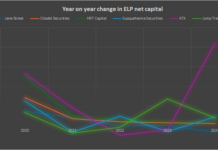The Association for Financial Markets in Europe (AFME) has published study consolidating fixed income trading data from numerous sources for the period of March to December 2021. According to AFME it makes the case that a majority of fixed income trades could be made transparent in near real-time, but also finds there is a clear need for a longer deferral period for the publication of larger or illiquid trades.
Data provided by FINBOURNE Technology for this study is used to argue that an inadequate deferral calibration, which AFME says is currently proposed by the European Commission (EC), could have potentially significant negative implications for market liquidity.
It argues that current proposals to reduce the amount of time that post-trading information can be deferred from publication could have a negative impact on liquidity for corporate bonds. This is especially true for large transactions or trades in bonds that are less liquid, as this would force liquidity providers to disclose their books to the market before they have unwound or hedged their positions, resulting in negative outcomes for investors and a direct hit to liquidity provision.
In turn, it argues that this could impact the availability and pricing of funding for EU corporates in primary debt markets, as investors in primary issuances need to have the confidence that they can adjust their portfolio as and when needed. To do so requires sufficient liquidity to be available in the secondary market, if there is a lack of liquidity then investors could encounter problems trading in the sizes they need, without triggering an adverse change in price. Therefore, the issuance price needs to be at a level that compensates for this, which translates into higher costs for the issuer.
It found that investors who will benefit most from increased transparency are smaller, less sophisticated investors whose trading activity will be concentrated in smaller sized trades.
In 2021, as part of the Markets in Financial Instruments Regulation (MiFIR) review, the Commission set out changes to bond market transparency which included harmonising the deferral regime and shortening post-trade publication delays.
The AFME paper analyses recent European fixed income trade data from around 5500 of the most frequently traded securities. The analysis focuses on the corporate bond landscape, rather than government bonds, to identify which types of trades could be subject to near real-time price and volume transparency, and which types of trades should be subject to deferrals.
From the data set studied, AFME and Finbourne found that different deferral periods need to be applied based on the trade size and issuance volume, among other characteristics. According to their analysis, applying the Commission’s proposed deferral regime to all trades, especially those larger in size or illiquid, risks exposing liquidity providers to potential undue risks, which could negatively impact the amount of liquidity/pricing that market makers are able to provide.

Adam Farkas, chief executive of AFME, said, “This report demonstrates both the value of having a high quality, consolidated view of bond trading in the EU and the potentially significant implications of inadequate deferral calibration. Current proposals to reduce the amount of time that post-trading information can be deferred from publication could have a negative impact on liquidity for corporate bonds. This is especially true for large transactions or trades in bonds that are less liquid, as this would force liquidity providers to disclose their books to the market before they have unwound or hedged their positions, resulting in negative outcomes for investors and a direct hit to liquidity provision. In turn, this could impact the availability and pricing of funding for EU corporates in primary debt markets, which is counterintuitive and not in line with the goals of the Capital Markets Union. Even the Commission proposals implicitly recognise that there can be downsides to publishing trade information too quickly because sovereign bonds will benefit from lengthy publication deferral periods.”
AFME highlighted certain findings of the report:
• Small trades (of less than €500k) account for the majority (c. 70%) of the overall number of trades in the data set and can support being reported in near real-time. Therefore, making these small transactions transparent could significantly improve transparency by almost 10 fold, increasing from 8% of transactions currently being reported real-time to almost 70% of transactions becoming real-time transparent.
• The smaller the trade size and the more liquid the instrument, the less risk is associated with rapid dissemination of price and volume information for liquidity providers, with the ‘trade out’ i.e. moving the risk off the bank’s balance sheet, being less than one day for liquidity providers.
• However, this 70% reflects 13% of market volume. Therefore, these transactions represent a much smaller percentage of market volume than of the number of trades.
• Larger transactions (of more than €500k) reflect a relatively small percentage of total transactions, accounting for approximately 30% of total transactions but a much larger share of market volume. The data set demonstrates that the larger the transaction, the longer it takes to ‘trade out’ and clear the market. For trades larger than €1 million, it takes on average six business days to ‘trade out’ of positions. For trades over €5 million it takes on average 19 days to trade out, while larger trades take even longer.
• The deferral regime should have a conceptual link between trade size categories i.e. real-time transparency, bond liquidity and deferral periods i.e. for a regime with a higher trade size, or deemed illiquid the deferral period should be longer.
• Investors who will benefit most from increased transparency are smaller, less sophisticated investors whose trading activity will be concentrated in smaller sized trades.
• At the same time, longer deferrals for the small number of large transactions should limit the risk of liquidity reduction in the market for institutional investors.
AFME therefore opposes a hardwiring of price and volume deferral calibration in primary legislation (as is currently proposed). Since each fixed income asset class will include a significant number of illiquid bonds, AFME urges the co-legislators to adopt a range of deferral periods, going beyond the Commission’s proposal for maximum deferral period for prices (by the end of the day) and volume (within two weeks). ESMA will then be able to calibrate the details of which bonds should go into the various deferral categories, which should be based off detailed and high-quality data .
Farkas says, “AFME is therefore calling on the co-legislators to ensure that corporate bonds are not treated less favourably than government bonds and to avoid hardwiring the proposed price and volume deferral calibration into primary legislation. A wider range of deferral periods calibrated to the realities of the fixed income market as demonstrated in this report is needed instead.”

Thomas McHugh, CEO and Co-Founder, at FINBOURNE Technology, said: “We are pleased to contribute data analysis to AFME’s study and support the formulation of evidence-based policy. Combining our data management expertise and publicly available MiFID transaction records, we have been able to aggregate over one million transaction records for this study. This includes, linking transactions to ESMA’s FIRDS database, normalising the divergent formats, and scenario-testing at a granular (ISIN by ISIN) level. Our belief is that by making the data fully transparent, we will help the market to address key issues that have hindered the successful development of a consolidated tape to date.”
©Markets Media Europe 2025













